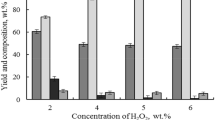Abstract
Brown rot fungi degrade wood, in initial stages, mainly through hydroxyl radicals (•OH) produced by Fenton reactions. These Fenton reactions can be promoted by dihydroxybenzenes (DHBs), which can chelate and reduce Fe(III), increasing the reactivity for different substrates. This mechanism allows the extensive degradation of carbohydrates and the oxidation of lignin during wood biodegradation by brown rot fungi. To understand the enhanced reactivity in these systems, kinetics experiments were carried out, measuring •OH formation by the spin-trapping technique of electron paramagnetic resonance spectroscopy. As models of the fungal DHBs, 1,2-dihydroxybenzene (catechol), 2,3-dihydroxybenzoic acid and 3,4-dihydroxybenzoic acid were utilized as well as 1,2-dihydroxy-3,5-benzenedisulfonate as a non-Fe(III)-reducing substance for comparison. Higher amounts and maintained concentrations of •OH were observed in the driven Fenton reactions versus the unmodified Fenton process. A linear correlation between the logarithms of complex stability constants and the •OH production was observed, suggesting participation of such complexes in the radical production.





Similar content being viewed by others
References
Hamilton GA, Hanifin JW, Friedman JP (1966) J Am Chem Soc 88:5269–5272
Kerem Z, Hammel KE (1999) FEBS Lett 446:49–54
Paszczynski A, Crawford R, Funk D, Goodell B (1999) Appl Environ Microb 65:674–679
Goodell B (2003) In: Goodell B, Nicholas DD, Schultz TP (eds) Wood deterioration and preservation. Advances in our changing world. ACS symposium series no 845. American Chemical Society, Washington, pp 97–118
Jensen KA Jr, Houtman CJ, Ryan ZC, Hammel KE (2001) Appl Environ Microb 67:2705–2711
Liu R, Goodell B, Jellison J, Amirbahman A (2005) Environ Sci Technol 39:175–180
Wang W, Gao PJ (2003) J Biotechnol 101:119–130
Goodell B, Nicholas DD, Schult TP (eds) (2003) Wood deterioration and preservation. Advances in our changing world. ACS symposium series no 845. American Chemical Society, Washington, pp 2–7
Hyde SM, Wood PM (1997) Microbiology143:259–266
Safarzadeh-Amiri A, Bolton JR, Carter SR (1996) J Adv Oxid Technol 1:18–26
Kaim W, Swederski B (1994) Bioinorganic chemistry: inorganic elements in the chemistry of life: an introduction and guide, 1 edn. Wiley, Chichester
Kremer ML (2003) J Phys Chem A 107:1734–1741
Filley TR, Cody GD, Goodell B, Jellison J, Noser C, Ostrofsky A (2002) Org Geochem 33:111–124
Xu G, Goodell B (2001) J Biotechnol 87:43–57
Moran JF, Klucas RV, Grayer RJ, Abian J, Becana M (1997) Free Radic Biol Med 22:861–870
Iwahashi H, Morishita H, Ishii T, Sugata R, Kido R (1989) J Biochem 105:429–434
Kawabata T, Schepkin V, Haramaki N, Phadke RS, Packer L (1996) Biochem Pharmacol 51:1569–1577
Faure M, Lissi E, Torres R, Videla LA (1990) Phytochemistry 29:3773–3775
Lopes GKB, Schulman HM, Hermes-Lima M (1999) Biochim Biophys Acta 1472:142–152
Zang LY, Cosma G, Gardner H, Castranova V, Vallyathan V (2003) Mol Cell Biochem 247:205–210
Raymond KN, Isied SS, Brown LD, Fronczek FR, Nibert JH (1976) J Am Chem Soc 98:1767–1774
Engelmann MD, Bobier RT, Hiatt T, Cheng IF (2003) Biometals 16:519–527
Contreras D, Freer J, Rodriguez J (2006) Int Biodeterior Biodegradation 57:63–68
Sever MJ, Wilker JJ (2006) Dalton Trans 813–822
Mentasti E, Pelizzeti E, Saini G (1973) J Chem Soc Dalton Trans 23:2690–2614
Avdeef A, Sofen SR, Bregante TL, Raymond KN (1978) J Am Chem Soc 100:5362–5370
Xu JH, Jordan RB (1988) Inorg Chem 27:1502–1507
Barreto WJ, Barreto SRG, Moreira I, Kawano Y (2006) Quim Nova 29:1255–1258
Mentasti E, Pelizzeti E, Saini G (1976) J Inorg Nucl Chem 38:785–788
Xu JH, Jordan RB (1988) Inorg Chem 27:4563–4566
Sanchez P, Galvez N, Colacio E, Minones E, Dominguez-Vera JM (2005) Dalton Trans 811–813
Rodriguez J, Parra C, Contreras, Freer J, Baeza J (2001) Water Sci Technol 44:251–256
Qian Y, Goodell B, Felix CC (2002) Chemosphere 48:21–28
Rodriguez J, Contreras D, Parra C, Freer J, Baeza J, Duran N (1999) Water Sci Technol 40:351–355
Oviedo C, Contreras D, Freer J, Rodriguez J (2004) Environ Technol 25:801–807
Goodell B, Qian YH, Jellison J, Richard M (2004) Water Environ Res 76:2703–2707
Rodriguez J, Contreras D, Oviedo C, Freer J, Baeza J (2004) Water Sci Technol 49:81–84
Finkelstein E, Rosen GM, Rauckman EJ (1980) J Am Chem Soc 102:4994–4999
Reszka KJ, McCormick ML, Buettner GR, Hart CM, Britigan BE (2006) Nitric Oxide Biol Chem 15:133–141
Yamazaki I, Piette LH (1990) J Biol Chem 265:13589–13594
Madden KP, Taniguchi H (2001) Free Radic Biol Med 30:1374–1380
Platenik J, Stopka P, Vejrazka M, Stipek S (2001) Free Radic Res 34:445–459
Pracht J, Boenigk J, Isenbeck-Schroter M, Keppler F, Scholer HF (2001) Chemosphere 44:613–619
Chen RZ, Pignatello JJ (1997) Environ Sci Technol 31:2399–2406
Suzuki MR, Hunt CG, Houtman CJ, Dalebroux ZD, Hammel KE (2006) Environ Microbiol 8:2214–2223
Goodell B, Daniel G, Jellison J, Qian YH (2006) Holzforschung 60:630–636
Acknowledgements
The authors are grateful to Eduardo Lissi for his comments on the results. Financial support for this work was provided by FONDECYT (grant No. 1040619) and DIUC (grant 206.021.024-1.0.) and a CONICYT-DAAD scholarship (D.C.).
Author information
Authors and Affiliations
Corresponding author
Rights and permissions
About this article
Cite this article
Contreras, D., Rodríguez, J., Freer, J. et al. Enhanced hydroxyl radical production by dihydroxybenzene-driven Fenton reactions: implications for wood biodegradation. J Biol Inorg Chem 12, 1055–1061 (2007). https://doi.org/10.1007/s00775-007-0274-2
Received:
Accepted:
Published:
Issue Date:
DOI: https://doi.org/10.1007/s00775-007-0274-2




